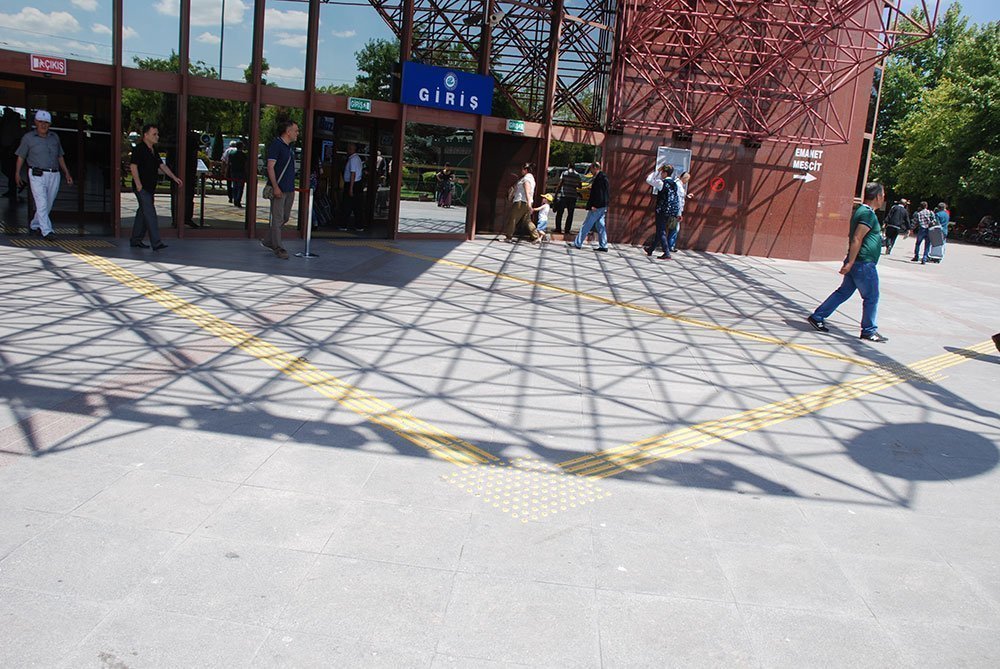What is the Visually Impaired Walkway Name?
The answer to questions such as the name of the visually impaired walking path, the name of the path that the visually impaired people walk can be given as a tangible surface. As the name suggests, the tactile surface is an embossed surface system that appeals to the sense of touch for the visually impaired and provides orientation to them. Sensible ground, tactile surface, tactile surface signs are the names used for the visually impaired road.
The relief, which is produced from stainless steel material, is generally made at a height of 2-5 mm from the ground. With the help of special adhesives, the floor can be owned and the use of screws can be preferred in areas where usage will be intense.
The visually impaired walking path is designed parallel to the movement direction of the disabled individual, providing a safe access to the destination. It also warns about obstacles in the environment.

Example Visually Impaired Walkway is shown in the image
Visually Impaired Walkway and Usage Areas
The tactile surface, which is used for visually impaired individuals, can be used almost everywhere. Since the safety of individuals is a priority in all areas and under all conditions, its use indoors as well as outdoors is very important.
pedestrian crossings,
airports,
Bus, metro, tram stops,
Top of sidewalks and ramps,
Public areas such as hospitals, banks, shopping malls,
Education and training institutions such as schools, universities, libraries,
Places of worship such as mosques and masjids are among the areas where the palpable surface is frequently used.
This palpable surface, which is the answer to the question of what is the name of the visually impaired walking path and whose use is obligatory in all areas where it can be used, is used in many areas other than those listed in order to facilitate the lives of visually impaired individuals and to prevent possible safety problems.
Required Features on Visually Impaired Roads
Apart from their main duties such as guiding individuals correctly, warning about obstacles in the environment, and being able to be easily felt, there are some features that all guiding surfaces should have.
It should be non-slip and easy to clean.
It should be resistant to chemicals.
It should not be affected by the sun’s rays and should not change color.
It should be resistant to summer or winter conditions.
It should be able to maintain its robustness against loaded and heavy vehicles that may pass over it.
It should be able to maintain its robustness and performance for a long time.
Products must be produced from materials that do not harm living things or the environment.
Apart from these substances, it is very important for individuals with low vision to be able to recognize their contrasting colors and to preserve this color for a long time. At the same time, in order not to mislead individuals and guide them towards dangerous or unintended exits, all research should be done before surfaces are placed, and the issue should not be viewed as any pavement.
Attention should be paid to the cleanliness of the area where the assembly will be made and assembly should not be carried out without removing all foreign objects. Apart from these, other factors to be considered concern individuals who are not visually impaired.
False attitudes such as parking a car or a bicycle on the tangible surface even for a short time, moving on this ground while walking with crowded groups, or preventing the actual use of the guide surface by using it for other than its intended purpose should be avoided.
After looking for answers to questions such as what is the tangible surface, what is the name of the visually impaired walking path, for what purposes this road is used and what should be considered in its use, although we come to the price information, it is not possible to determine a clear cost for the floor in question.
The price is determined as a result of many factors such as the quality of the material used, the quantity, and the type of coating.






